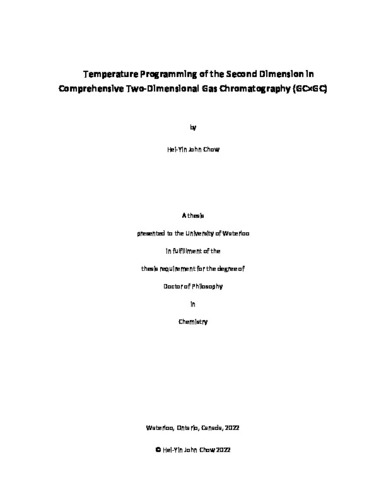| dc.description.abstract | Comprehensive two-dimensional gas chromatography (GC×GC) is a mature separation technique that is now over three decades old. It separates all sample components using two GC columns with different selectivities, connected in series through a special interface called a modulator to provide two dimensions of separation. Early research and development of this technique focused on the modulator, the most critical component in a GC×GC system. The modulator facilitates the collection and transfer of effluent from the first dimension (¹D) to the second dimension (²D) column. As the modulator development matured with various designs being commercialized, research focus shifted towards chemometrics and applications. However, a fundamental issue that has not been resolved thus far in GC×GC is the general elution problem in ²D due to the nearly isothermal conditions in this dimension during a single separation. This thesis details the development, testing, and application of a ²D temperature programming system for GC×GC to overcome this problem.
Every stage of development for the ²D temperature programming system is described, from the proof-of-concept to the final design. The proof-of-concept system in Chapter 2 focused on the heating and cooling aspects of ²D temperature programming. It featured a ballistic heating system that synchronized the heating and cooling of the ²D column to the modulation period. Although the final temperature offset could be pre-calibrated, the system did not feature any real temperature control. Despite its simplicity, ballistic heating eliminated wraparound peaks while maintaining the separation of weakly retained compounds in the ²D.
The first prototype of a true ²D temperature programming system, detailed in Chapter 3, featured an Arduino microcontroller for PID temperature control. The temperature difference between the ²D column and the GC oven was measured directly using two thermocouples connected differentially. Although ²D temperature programming with the prototype improved the peak capacity by 48 %, the fragility of the thermocouple attachment was an issue for commercial designs.
The final version of the ²D temperature programming system (²DTPS), described in Chapter 4, tackled the robustness and user-friendliness of the system, building upon the core functions from the prior designs. The temperature measurement system was completely redesigned to determine the ²D column temperature based on the ²D column electrical resistance. The column connections and column cage were also redesigned to incorporate longer ²D columns and provide a more secure connection to the column for heating and resistance measurement. A real time clock and remote port were also added to allow the ²DTPS to be a completely standalone device for any GC×GC system. A Windows Forms application was written to control and monitor the ²DTPS. System compatibility was tested with both thermal and flow modulators, as well as a flame ionization detector (FID) and time-of-flight mass spectrometer (TOFMS).
Finally, the ²DTPS was applied to the characterization of renewable hydrocarbon samples from a local Ontario company in Chapter 5. Samples from various points in the production process were characterized to help with product development. The GC×GC separation with the ²DTPS was optimized with both a normal and a reverse column set, as well as two detectors, an FID and a TOFMS. The ²DTPS improved the signal-to-noise ratio and peak capacity for the characterization of the samples. | en |

